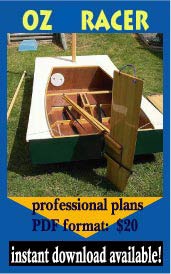
 Custom Search
|
| sails |
| plans |
| epoxy |
| rope/line |
| hardware |
| canoe/kayak |
| sailmaking |
| materials |
| models |
| media |
| tools |
| gear |
| join |
| home |
| indexes |
| classifieds |
| calendar |
| archives |
| about |
| links |
| Join Duckworks Get free newsletter CLICK HERE |
|
|
| Memories of Last Summer |
by John Welsford - Hamilton - New Zealand |
Part 1 - Part 2 - Part 3 - Part 4 - Part 5 Part 2: Heading for Mahurangi In the grey dawn of next morning I was up and breakfasted early, the big classic boat regatta at Mahurangi was on the following day and I had about 25 miles to cover to be in the anchorage that night. The forecast was for fresh winds N/West, that would be a headwind, changing to South West mid afternoon. Although it was calm in where we had anchored, it looked pretty black outside so I put a reef in before getting under way, spent a few minutes tidying up on deck and making sure that all was secure below and on deck, the dinghy oars lashed down on the side deck, the plug in the navel pipe and the anchor in its chocks. I made a Thermos of hot chocolate, put a packet of granola bars in the cockpit locker, some fruit, and put the heavy wet weather clothes on, checked the outboard motor fuel level, put my safety harness on and we were away. This turned out to be not one of the more enjoyable sails! It was blowing at about 25knots, gusting 35 at times (Davis wind meter) with close steep breaking seas high enough so I could not see the horizon when standing in the cockpit. Double reefed, threading my way through the many islands and reefs in the area Spook made fair progress until early in the afternoon when we sailed into a major squall. Poor visibility meant that it would be difficult to navigate through a three sided “box” of navigational hazards within which we were sailing when the squall came over. Made up of a chain of islets, some reefs, and two reasonably big islands, this “box” on the water is about 3 miles a side. Its well charted and I know it well enough to sail through between the reefs without any worries in normal conditions, but in very high wind and rain with visibility down to about two boat lengths and worsening I chose to go about and head back out along the reciprocal of my compass course to avoid meeting up with any of the obstacles. When I could see again I took a compass bearing on two prominent points to obtain a position and from there set course for a known very sheltered anchorage at Home Bay on Motutapu island, one of the barrier islands that protect the entrance to Auckland's Waitemata harbour. It was about 2:30 pm when I got the anchor down, I’d been on the go since 5:30 am and only made good about 15 miles! It had been interesting sailing though, I now have great confidence in Spook with her wineglass sections and long keel, gaff rig and heavy displacement, although the weather had been seriously nasty she never gave me a moments concern, it had been a good test. I heated up a quick meal, and as I had still quite a few hours sailing to go before I would be at my destination I got my head down for a nap while I awaited more clement weather. I was still asleep below when the wind changed at about 4 30 pm, the change in the way the boat was moving to the waves waking me from a light but refreshing nap. Although a couple of hours out the forecast sou/westerly change had arrived sending a swell into the bay, so it was a quick bite to eat, up sails, up anchor, clip the harness to the jackline and we, Spook, Offcuts and I, were off around the point and running hard for Mahurangi some 15 miles away. What a sail! Still double reefed, the little boat fair scampered along with a great white wake, bouncing and rolling through a steep chop that the 20 knot wind had set up blowing against the tide, the lowering sun making the water a very deep blue against which the cresting wave tops were amazingly white. The Mahurangi regatta is an annual event, mainly for classic and traditional yachts we see everything from tiny trailered home built dinghies to 70 ft classic racers from the early 1900s or even older. These graceful old racehorses make a race of the journey from Auckland to Mahurangi, overtaking me on the run toward the rivermouth harbour. They had perfect conditions for real speed this day, roaring along under a huge press of sail with the sails glowing rose red in the sunset, the crew working hard all the way and very kindly sailed through my lee so as not to blanket the wind of a much smaller sister, that’s nice! What a spectacle though, some of those old boats are real treasures, wonderfully fast and graceful, the best of times gone by indeed. On the very last of the light I sailed Spook in among the several hundred boats anchored in the harbour, looking for a gap well in toward the beach where the regatta would be based next day, I’ve been going to Mahurangi on this day for over 30 years now and have not missed many so know the beach and the anchorage very well, and was happy to tuck myself away in the shallows at one end. At a guess there would have been 200 boats there, and more further up the harbour so being in the shallows kept the bigger boats with partying crews far enough away to ensure me a peaceful night. I did though check the depth with the trusty lead line before going below to cook up my evening meal. Before I set off from Waiheke that morning, I’d opened the icebox, taken out the items for the evening’s meal and put them in the galley sink to defrost, so it was not long before I was dining on a reheated beef stew with rice and fresh vegetables. I like to eat properly when cruising; it makes the experience of living on board much more like home. I woke a couple of times that night, sitting up and looking around to make sure I had not dragged and that I was still clear of all the neighbouring boats. It was like being anchored in the midst of the Milky Way, hundreds of anchor lights high up in the fleets masts were quite a surreal sight. I can recall a voice from an old movie, it’s about all I can recall of it though “six bells and all’s well”. That I think would be about three am, I lay down, rolled over, time for more sleep. Next: Regatta day! John's Plans are in our Duckworks Store. |
|



